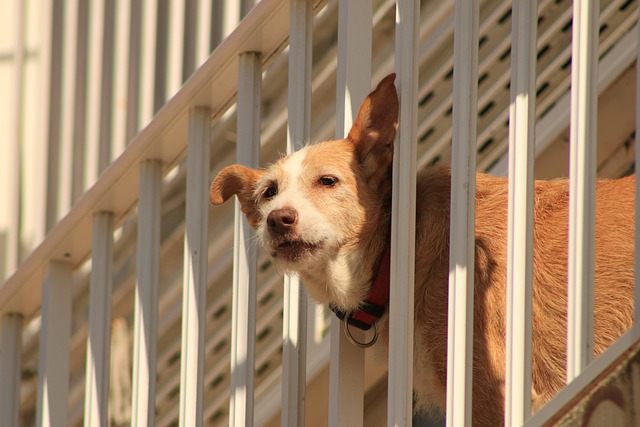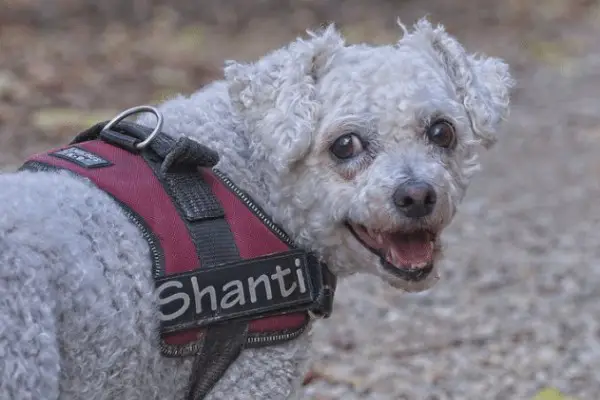Identifying Territorial Aggression in Dogs & Fix

Hey there, fellow dog lovers! Let’s talk about a common challenge many dog owners face: territorial aggression in dogs.
In this blog post, we’ll explore what it is, why it happens, and most importantly, how you can help your furry friend overcome this behavior.
What is Territorial Aggression in Dogs?
Territorial aggression in dogs refers to aggressive behavior displayed by a dog towards individuals or animals that enter its perceived territory.
This behavior is often triggered by a dog’s instinct to protect its territory and can manifest as barking, growling, lunging, or even biting.
It is important for dog owners to address territorial aggression through proper training and socialization to ensure the safety of both the dog and others.
Signs of Territorial Aggression in Dogs
Territorial aggression in dogs is a behavior where a dog displays aggressive behaviors towards individuals or animals that enter its perceived territory.
Here are some signs of territorial aggression in dogs:
Barking and Growling: Dogs exhibiting territorial aggression often bark and growl excessively when someone or something approaches their territory. This behavior is a warning to the intruder to stay away.
Lunging and Snapping: Dogs may lunge towards the intruder and snap at them, attempting to intimidate or bite them. This aggressive behavior is a defensive response to protect their territory.
Showing Teeth: Dogs may bare their teeth and display an aggressive facial expression when they feel their territory is being invaded. This is a clear warning sign that they are ready to defend their space.
Raised Hackles: When a dog’s hackles, the fur along their back, are raised, it indicates heightened arousal and aggression. This physical response is a way for dogs to appear larger and more intimidating to potential threats.
Guarding Behavior: Dogs with territorial aggression may exhibit guarding behaviors, such as standing in front of the territory, blocking access, or refusing to let anyone approach. They may also mark their territory with urine or other scent markings.
Defensive Posture: Dogs displaying territorial aggression often adopt a defensive posture, with their body tense, tail raised, and ears forward or flattened. They may also have a stiff gait and maintain strong eye contact with the intruder.
Read more about how to know aggression in dogs.
Causes of Territorial Aggression in Dogs
There are several major causes of territorial aggression in dogs, which can vary from individual to individual.
Here are some common causes:
1. Instinctual Behavior: Dogs have a natural instinct to protect their territory, which includes their home, yard, and belongings. This instinct can manifest as territorial aggression when they perceive someone or something as a threat to their territory.
2. Lack of Socialization: Dogs that have not been properly socialized may be more prone to territorial aggression. When dogs are not exposed to different people, animals, and environments during their critical socialization period, they may become fearful or defensive when faced with unfamiliar situations.
3. Fear and Insecurity: Dogs that are fearful or insecure may exhibit territorial aggression as a way to protect themselves and their territory. They may perceive any unfamiliar person or animal as a potential threat and respond aggressively to defend their space.
4. Resource Guarding: Resource guarding is a behavior where dogs become possessive and protective of their valued resources, such as food, toys, or sleeping areas. Dogs displaying resource-guarding behavior may show territorial aggression when someone approaches or tries to take away their resources.
5. Lack of Training and Boundaries: Dogs that have not received proper training and boundaries may be more likely to exhibit territorial aggression. Without clear guidance and consistent rules, dogs may develop a sense of entitlement over their territory and become more prone to aggressive behavior.
6. Previous Negative Experiences: Dogs that have had negative experiences in the past, such as being attacked or threatened in their territory, may develop territorial aggression as a defensive response. These dogs may associate their territory with danger and react aggressively to prevent similar situations from occurring again.
Read more about possible reasons for your dog’s aggression.
How to Stop Territorial Aggression in Dogs
Territorial aggression in dogs can be a challenging behavior to address, but there are several strategies that can help manage and reduce this type of aggression.
Here are some ways to stop territorial aggression in dogs:
1. Socialization: Proper socialization is crucial for dogs to learn appropriate behavior around other dogs and people. Exposing your dog to different environments, situations, and individuals from a young age can help them become more confident and less prone to territorial aggression.
2. Positive reinforcement training: Using positive reinforcement techniques, such as rewards and praise, can help redirect your dog’s behavior and reinforce desired actions. Rewarding your dog for calm and non-aggressive behavior can help them associate positive experiences with situations that may trigger territorial aggression.
3. Desensitization and counterconditioning: Desensitization involves gradually exposing your dog to the stimuli that trigger their territorial aggression, starting with low-intensity versions and gradually increasing the intensity over time. Counterconditioning involves pairing the presence of the trigger with positive experiences, such as treats or play, to change your dog’s emotional response from aggression to a more positive one.
4. Management and environmental modifications: Managing your dog’s environment can help prevent situations that trigger territorial aggression. This can include using baby gates or crates to separate your dog from visitors or other dogs, providing a safe and quiet space for your dog, and avoiding situations that may provoke territorial behavior.
5. Consistency and clear boundaries: Establishing consistent rules and boundaries for your dog can help them understand what is expected of them and reduce their need to assert territorial behavior. Providing clear cues and commands, such as “sit” or “stay,” can help redirect their attention and focus away from territorial triggers.
6. Seek professional help: If your dog’s territorial aggression persists or escalates despite your efforts, it may be beneficial to seek the assistance of a professional dog trainer or behaviorist. They can provide personalized guidance and develop a behavior modification plan tailored to your dog’s specific needs.
Remember, addressing territorial aggression in dogs requires patience, consistency, and a commitment to positive reinforcement-based training methods.
Read more about how to fix dog aggression.
Consequences of Ignored Territorial Aggression in Dogs
Ignoring territorial aggression in dogs can have several consequences, which are discussed below:
Increased Risk of Injury: Ignoring territorial aggression in dogs can lead to an increased risk of injury to both humans and other animals. Dogs may bite or attack when they feel their territory is being encroached upon, which can result in serious injuries.
Legal Consequences: If a dog with territorial aggression issues injures someone, the owner may face legal consequences. Depending on the severity of the incident, the dog may be labeled as dangerous, and the owner may be held liable for any damages or injuries caused.
Isolation and Restricted Socialization: Dogs with territorial aggression may need to be isolated or have restricted socialization to prevent conflicts with other animals or people. This can lead to a decrease in the dog’s overall quality of life and limit their opportunities for positive social interactions.
Stress and Anxiety: Ignoring territorial aggression can contribute to increased stress and anxiety in dogs. Dogs that constantly feel the need to defend their territory may experience heightened levels of stress, which can negatively impact their overall well-being.
Reinforcement of Aggressive Behavior: Ignoring territorial aggression can reinforce and perpetuate aggressive behavior in dogs. If the dog’s aggressive behavior is not addressed and managed appropriately, it may become more ingrained and difficult to modify over time.
Preventing Territorial Aggression in Dogs
Territorial aggression in dogs can be a challenging behavior to manage, but there are several strategies that can help prevent or reduce this type of aggression.
Here are some ways to prevent territorial aggression in dogs:
1. Early socialization: Proper socialization from a young age is crucial in preventing territorial aggression. Expose your dog to various people, animals, and environments to help them become comfortable and confident in different situations. This can help reduce their need to be overly protective of their territory.
2. Positive reinforcement training: Use positive reinforcement techniques to train your dog and reward them for calm and non-aggressive behavior. Teach them basic obedience commands like “sit,” “stay,” and “leave it.” This will help establish you as the leader and give you control over their behavior.
3. Controlled introductions: When introducing your dog to new people or animals, do so in a controlled and supervised manner. Gradually expose them to new stimuli and monitor their behavior closely. If your dog shows signs of aggression, redirect their attention and reward them for calm behavior.
4. Secure boundaries: Ensure that your dog’s territory is properly secured with fences or gates to prevent them from feeling the need to defend it excessively. This can help reduce territorial aggression by creating a clear boundary for your dog.
5. Avoid triggering situations: Identify and avoid situations that may trigger territorial aggression in your dog. For example, if your dog becomes aggressive when people approach your home, consider keeping them in a separate room or using a baby gate to create a safe space during visitor arrivals.
6. Consistency and routine: Dogs thrive on consistency and routine. Establish a regular schedule for feeding, exercise, and training. This can help reduce anxiety and provide a sense of security for your dog, which may help prevent territorial aggression.
Read more about the strategies for preventing dog aggression.
Frequently Asked Questions
How can I manage territorial aggression in my dog?
Managing territorial aggression requires a multi-faceted approach. It’s crucial to establish yourself as the leader and provide consistent training and socialization to help your dog feel more secure. Additionally, creating a positive association with strangers or unfamiliar individuals entering your dog’s territory can also be helpful.
Can territorial aggression be prevented in dogs?
While some dogs may be more prone to territorial aggression due to their breed or genetic predisposition, early socialization, and positive reinforcement training can significantly reduce the likelihood of developing territorial aggression. It’s important to expose your dog to different environments, people, and animals from an early age.
Should I punish my dog for displaying territorial aggression?
Punishing a dog for territorial aggression can worsen the problem and increase fear or anxiety. Instead, focus on positive reinforcement training techniques to redirect your dog’s behavior and reward them for calm and non-aggressive responses.
When should I seek professional help for my dog’s territorial aggression?
If your dog’s territorial aggression is severe, posing a risk to others or causing significant distress, it’s best to seek the assistance of a professional dog trainer or animal behaviorist. They can assess the situation and provide tailored guidance and training techniques to address the specific needs of your dog.
Read more about other types of dog aggression.
Conclusion
So, there you have it! Remember, tackling territorial aggression in dogs requires patience, understanding, and consistent training.
By establishing boundaries, providing positive reinforcement, and seeking professional help when needed, you can create a harmonious environment where your furry friend feels safe and secure.
Happy training, and may your pup’s territorial woes be a thing of the past!



![How To Discipline a Beagle [10 Insights] How To Discipline a Beagle](https://petcreeks.com/wp-content/uploads/2023/05/How-To-Discipline-a-Beagle-768x555.jpg)


